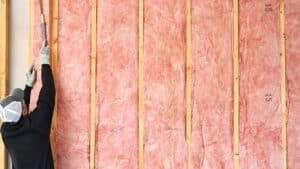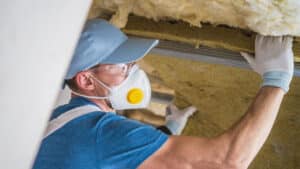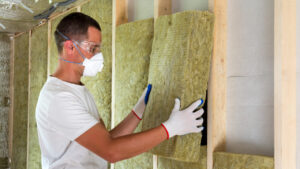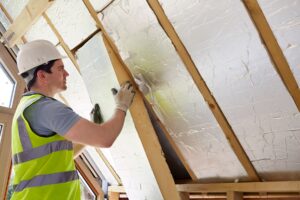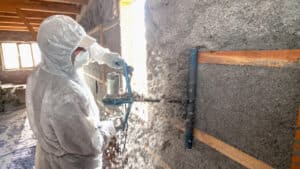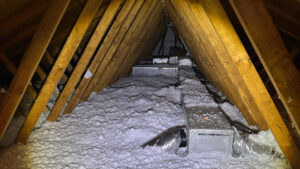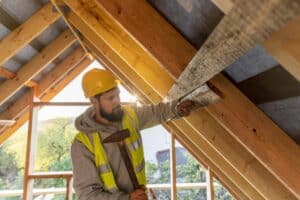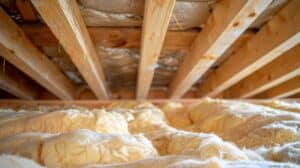Are you struggling to choose between cellulose and fiberglass insulation for your attic? This article compares these two popular thermal insulation options, focusing on why cellulose is often the better choice for most homeowners in Hampton Roads.
We’ll explore what cellulose and fiberglass building insulation are, their key differences, and the advantages of cellulose in terms of heat retention and overall performance. By the end, you’ll understand why cellulose insulation might be the superior option for your home, helping you make an informed decision to improve your attic’s energy efficiency.
What Are Cellulose and Fiberglass Insulation?
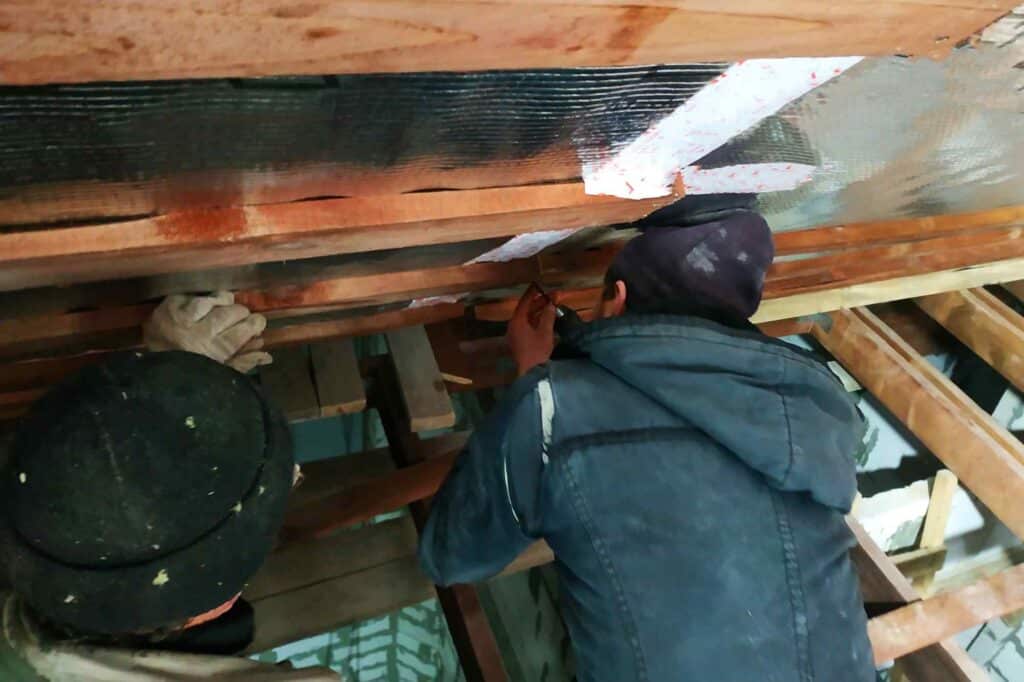
Cellulose insulation is made from recycled paper products, primarily newspaper, treated with fire-retardant chemicals. It’s known for its excellent pest resistance and ability to fill small gaps around plumbing and electrical fixtures.
Fiberglass insulation consists of extremely fine glass fibers and is available in batts or as a blown-in product. It’s commonly used in attics, walls, and floors, providing effective thermal resistance without interfering with ductwork or roofing structures.
Both cellulose and fiberglass insulations offer good thermal performance, but cellulose typically has a higher R-value per inch. This means cellulose can provide better insulation in areas with limited space, such as between roof rafters.
While neither material is as airtight as spray foam insulation, both cellulose and fiberglass can be effective when properly installed. Cellulose, however, tends to settle less over time and provides better sound-dampening properties compared to fiberglass.
Why is Cellulose the Better Option for Most Homeowners?
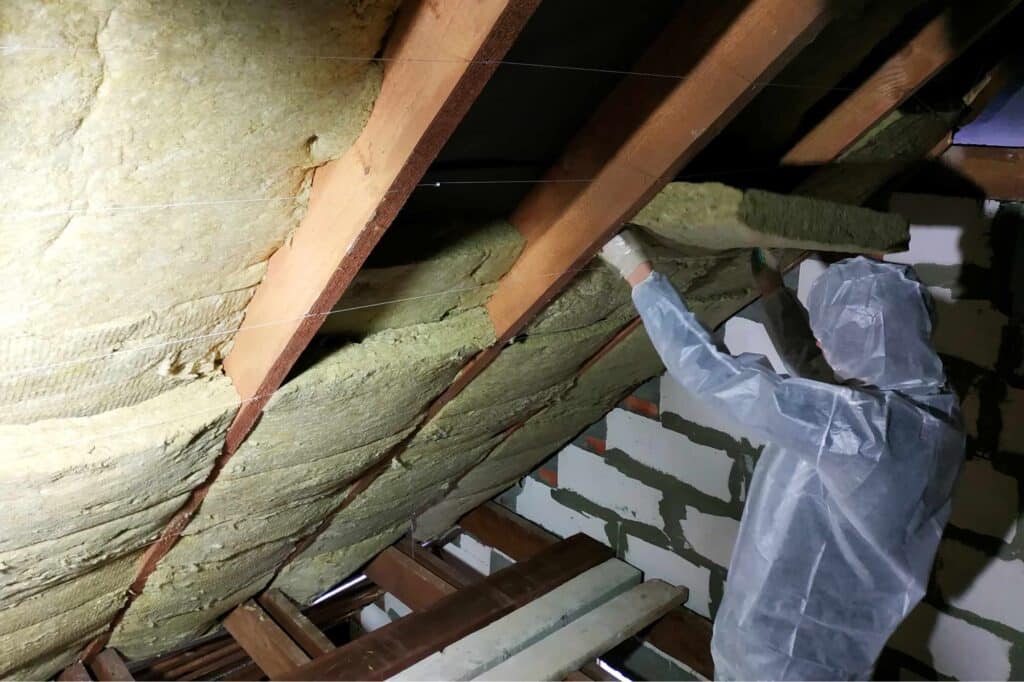
Cellulose insulation offers several advantages for homeowners, making it a superior choice over fiberglass. It provides excellent thermal performance, energy savings, and eco-friendliness. Cellulose also excels in fire resistance, noise reduction, and pest control. Its effectiveness in winter and suitability for crawl spaces further enhance its appeal.
These benefits contribute to improved air conditioning efficiency and protection against mildew. For those considering an upgrade, understanding the benefits of upgrading attic insulation can provide additional insights into how to enhance home comfort and efficiency.
It Keeps Your Home Warm
Cellulose insulation excels at keeping homes warm by effectively reducing heat transfer through walls, floors, and attics. It has a higher R-value per inch, typically ranging from 3.2 to 3.8, while fiberglass offers only 2.2 to 2.7 per inch. This means cellulose can achieve the same level of insulation with less material, making it particularly useful in spaces with limited room for insulation.
Also, cellulose insulation’s dense structure and ability to fill small gaps create a superior thermal barrier, minimizing energy loss and promoting energy conservation. This means cellulose can achieve the same level of insulation with less material, making it particularly useful in spaces with limited room for insulation.
The moisture-regulating properties of cellulose insulation helps maintain a consistent indoor temperature while preventing condensation that can lead to mold growth. By creating a more stable thermal environment, cellulose insulation reduces the workload on heating systems, leading to improved energy efficiency and lower utility bills.
This makes it an excellent choice for homeowners seeking both comfort and cost savings. For more insights on improving home efficiency through insulation, consider reviewing the role of insulation and air conditioning in enhancing energy performance.
It Saves Energy and Money
Cellulose insulation outperforms fiberglass and mineral wool in energy efficiency, leading to substantial cost savings for homeowners. Its dense structure minimizes air infiltration, reducing the workload on heating and cooling systems. This results in lower energy bills and improved overall comfort, even in homes with older wall construction.
Unlike spray foam, cellulose offers a more cost-effective solution without compromising on performance. Its ability to fill small gaps and voids in walls ensures consistent insulation throughout the home, eliminating cold spots and drafts. This coverage translates to long-term energy savings and increased property value, making cellulose a wise investment for budget-conscious homeowners.
It’s an Eco-Friendly Choice
Cellulose insulation stands out as an environmentally friendly choice for homeowners. Made from recycled paper products, it reduces landfill waste and requires less energy to produce compared to fiberglass. This sustainable option also helps conserve space in attics and walls due to its higher density, making it an efficient insulator in tight areas.
The eco-friendly benefits of cellulose extend beyond its production. It effectively deters insects without harmful chemicals, minimizing the need for pest control treatments. Additionally, cellulose insulation produces less dust during installation, creating a healthier environment for both installers and homeowners. The table below highlights the eco-friendly aspects of cellulose insulation:
| Eco-Friendly Aspect | Benefit |
|---|---|
| Recycled Content | Reduces landfill waste |
| Energy-Efficient Production | Lower carbon footprint |
| Space-Saving | Efficient use of materials |
| Natural Pest Deterrent | Reduces the need for chemical treatments |
| Low-Dust Installation | Healthier for installers and homeowners |
Fire Resistant
Cellulose insulation offers superior fire resistance compared to fiberglass, significantly slowing the spread of flames through walls and ceilings. Its dense structure restricts airflow, limiting oxygen supply to potential fires and providing crucial extra minutes for evacuation and emergency response.
When installed behind drywall, cellulose creates a strong fire barrier that protects structural elements and windows. Its ability to pack tightly into small spaces, even at a thickness of just one inch, ensures comprehensive coverage and enhanced fire safety throughout the home.
It Blocks Noise
Cellulose insulation excels in soundproofing, offering superior noise reduction compared to fiberglass. Insulation companies often recommend cellulose for its ability to dampen both airborne and impact sounds, creating a quieter living environment. This makes cellulose an ideal choice for homeowners seeking comprehensive insulation services that address thermal and acoustic needs.
The dense structure of cellulose effectively absorbs sound waves, reducing noise transmission through walls, floors, and ceilings. Insulation service providers highlight cellulose’s role in enhancing the building envelope, not only improving energy efficiency but also creating a more peaceful indoor atmosphere. This dual benefit makes cellulose insulation a smart investment for homeowners looking to improve their overall quality of life.
Repels Pests
Cellulose insulation effectively repels pests due to its dense construction and fire-retardant properties. The tightly packed fibers create a barrier that insects and small rodents find difficult to penetrate, offering superior protection compared to fiberglass. This natural pest resistance extends throughout the insulated areas, including walls and attics.
The pest-repelling qualities of cellulose insulation contribute to its overall effectiveness in creating a comfortable living environment. By reducing pest intrusion, cellulose helps maintain indoor air quality and minimizes potential damage to the home’s structure. Additionally, the insulation’s high density not only deters pests but also enhances its noise reduction capabilities, offering homeowners multiple benefits:
| Benefit | Impact |
|---|---|
| Pest Resistance | Reduces the likelihood of infestations |
| Structural Protection | Minimizes pest-related damage |
| Indoor Air Quality | Improves by limiting pest presence |
| Noise Reduction | Enhanced due to high-density |
It Works Well in Winter
Cellulose insulation performs exceptionally well in winter, particularly in regions with harsh climates. Its dense structure effectively combats the stack effect, reducing heat loss through convection and maintaining a consistent indoor temperature. The material’s ability to regulate moisture helps prevent condensation issues common in cold weather, ensuring optimal insulation performance throughout the winter months.
The superior winter performance of cellulose insulation stems from its unique properties. It resists air movement more effectively than fiberglass, minimizing heat loss and drafts. This efficiency translates to lower heating costs and improved comfort for homeowners. The benefits of cellulose insulation in winter include:
- Enhanced protection against cold air infiltration
- Improved moisture management
- Reduced energy consumption for heating
- Consistent indoor temperature maintenance
- Decreased risk of ice dam formation on roofs
Cellulose insulation maintains its R-value even in extreme cold, unlike fiberglass which can lose effectiveness in low temperatures. This makes cellulose particularly beneficial for homeowners in Hampton Roads, where winter temperatures can fluctuate significantly.
Upgrade Your Home’s Comfort with Cellulose Insulation Today!
Don’t let your energy bills soar and your comfort suffers. Universal Insulation Doctor is your trusted partner for superior cellulose insulation solutions. Our expert team will ensure your home stays cozy year-round while reducing your carbon footprint and energy costs. Experience the benefits of higher R-values, better soundproofing, and eco-friendly materials.
Contact Universal Insulation Doctor now for a free consultation and take the first step towards a more efficient, comfortable home!
Frequently Asked Questions
What are the main differences between cellulose and fiberglass insulation?
Cellulose and fiberglass insulation differ in material, installation, and performance. Cellulose, made from recycled paper, is denser and better at air sealing. Fiberglass, made from glass fibers, is lighter and less expensive. Both offer effective thermal insulation, but cellulose has a higher R-value per inch.
Is cellulose insulation more eco-friendly than fiberglass?
Cellulose insulation is generally considered more eco-friendly than fiberglass. Made from recycled paper products, it has a lower carbon footprint and requires less energy to produce. Cellulose also provides better insulation performance, reducing energy consumption in homes over time.
How does cellulose insulation compare to fiberglass in terms of cost?
Cellulose insulation typically costs less than fiberglass, with prices ranging from $0.60 to $1.80 per square foot installed, compared to fiberglass at $0.80 to $2.50 per square foot. However, costs can vary based on location, project complexity, and material quality.
Does cellulose insulation provide better sound dampening than fiberglass?
Cellulose insulation generally provides better sound dampening than fiberglass. Its denser composition and ability to fill gaps more effectively help reduce sound transmission between walls and floors. However, both materials can significantly improve a home's acoustics when properly installed.
Are there any drawbacks to choosing cellulose over fiberglass insulation?
Cellulose insulation can be more prone to moisture absorption than fiberglass, potentially leading to mold growth if not properly installed. It may also settle over time, reducing its effectiveness. Additionally, cellulose can be more expensive upfront and may require more frequent replacement than fiberglass insulation.

